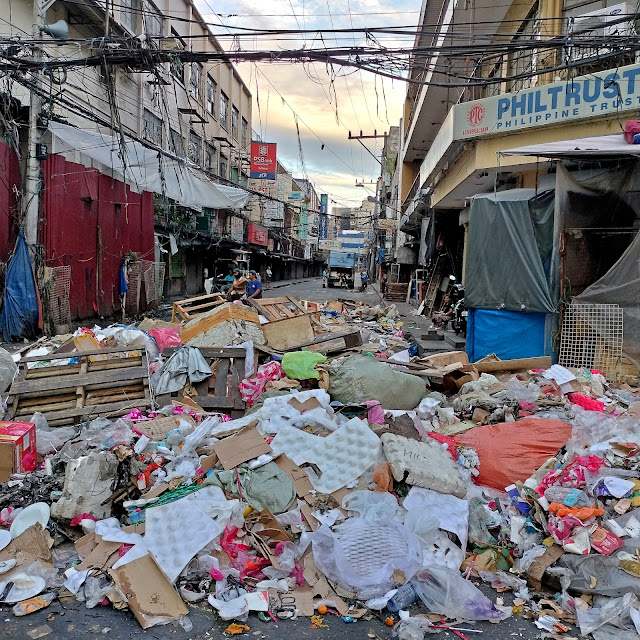EcoWaste Coalition Laments Piles of Mixed Garbage in Metro Streets After New Year’s Revelry
 |
| Garbage litter Tabora and M. de Santos Streets, Binondo, Manila the morning after the New Year revelry. ECOWASTE COALITION. |
The EcoWaste Coalition, a watchdog group campaigning for a zero waste and toxics-free society, has expressed its dismay over the heaps of mixed "holitrash" (holiday trash) dotting the streets of Metro Manila following the New Year’s Eve festivities.
According to the ocular monitoring conducted early this morning by the group’s Basura Patrollers, mounds of garbage consisting of food waste, disposable beverage and food containers, and other discards from the joyful gatherings and parties, including firecracker and firework debris, were seen in many places, especially in populated residential neighborhoods. Streets not designated by the authorities as a firecracker zone were also found strewn with burnt firecrackers.
In market areas in Manila, Pasay and Quezon Cities, the group noted the large amounts of abandoned mixed wastes from the last-minute shopping spree last Saturday such as corrugated boxes, polystyrene fruit containers, plastic and wooden fruit crates, rotten fruits, vegetable scraps and other organics, and lots of plastic packaging materials. In Tabora and M. de Santos Streets in Binondo where dozens of street vendors ply their trade, a backhoe loader was used to shovel the massive garbage to a compactor truck.
“Some of the sweepers and waste collectors have to work in the early hours of New Year's Day to remove garbage from the streets before people wake up," said Jove Benosa, Zero Waste Campaigner, EcoWaste Coalition.
"The mixed garbage piled up along roads and sidewalks is a stark reminder of the need to step up current efforts at all levels to counter the throw-away culture with a sustainable lifestyle that will, among other things, respect and care for Mother Earth, conserve resources, safeguard human health and, of course, prevent and reduce trash,” he pointed out.
“Our society cannot continue depleting the earth’s diminishing resources and churning out waste with little or no regard to their consequences,” he said. “As the national and international zero waste month is observed this January, let us learn and celebrate how zero waste strategies can help us cut back on what we dispose of, turn waste into resources and promote green jobs without incineration, while reducing the emission of dangerous pollutants such as dioxins, greenhouse gases and heavy metals.”
According to figures obtained from the website of the National Solid Waste Management Commission (NSWMC), Metro Manila’s projected waste generation in 2022 was 3.6 million tons per year. For 2023, it is projected to reach 3.7 million tons. Based on government estimates, food and organic discards constitute 52 percent of Metro Manila’s waste, 41 percent are recyclables and 7 percent are residuals.
“To prevent and reduce waste, manufacturers need to switch to sustainable business practices such as by adopting eco-design and extending their responsibility to what they make throughout the product life cycle, including managing the waste,” Benosa said.
“To prevent and reduce waste, local government units need to improve the implementation of the basic provisions of Republic Act 9003, or the Ecological Solid Waste Management Act, especially the need to enforce waste separation at source and set up Materials Recovery Facilities (MRFs),” he said.
“To prevent and reduce waste, we, the people, should consume with health and the environment in mind, shun single-use plastics, sort out our discards, and make reuse, repair, recycling and composting a habit,” he concluded. "A zero waste and toxics-free future is possible."
References:
- https://www.officialgazette.go
v.ph/2001/01/26/republic-act- no-9003-s-2001/ - https://nswmc.emb.gov.ph/ (go to Solid Waste Generation)








Comments